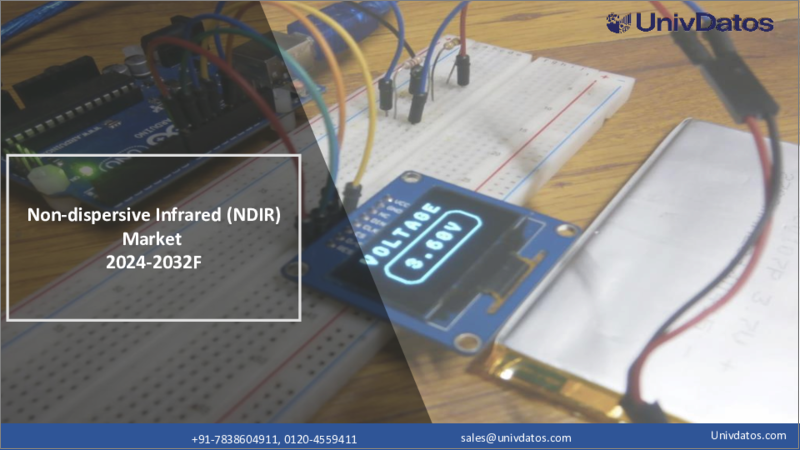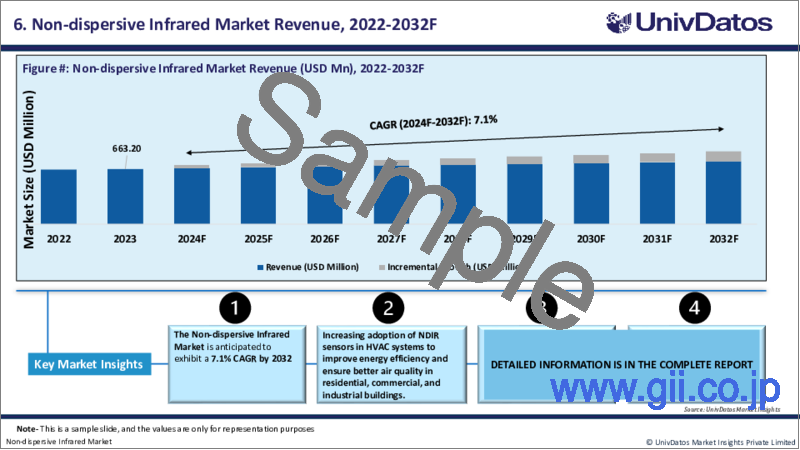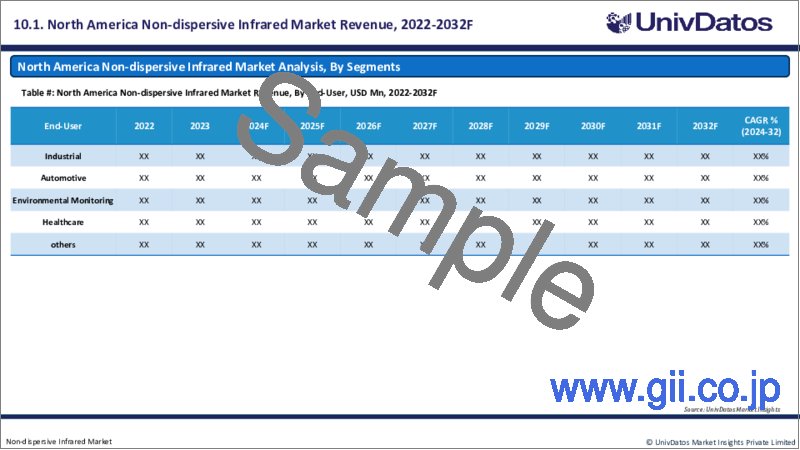|
|
市場調査レポート
商品コード
1570981
NDIR市場:現状分析と予測(2024-2032年)Non-dispersive Infrared (NDIR) Market: Current Analysis and Forecast (2024-2032) |
||||||
カスタマイズ可能
|
|||||||
| NDIR市場:現状分析と予測(2024-2032年) |
|
出版日: 2024年09月01日
発行: UnivDatos Market Insights Pvt Ltd
ページ情報: 英文 146 Pages
納期: 即日から翌営業日
|
全表示
- 概要
- 目次
NDIR市場は、厳しい環境規制とエネルギー効率の高いシステムの必要性により、正確で信頼性の高いガス検知ソリューションへの需要が高まっているため、予測期間中にCAGR 7.1%の堅調な成長が見込まれています。NDIR市場の現在の動向と取引は、業界が新技術の創出とポートフォリオの多様化に注力していることを説明しています。例えば、日本を拠点とする旭化成マイクロデバイス(AKM)は2018年1月、スウェーデンを拠点とするNDIRガスセンサーモジュールのメーカーであるSenseair ABの株式を取得することで提携しました。AKMは、コア技術である化合物半導体を用いて、不可視光(IRやUVなど)の検出を利用した事業の実現を強化しています。AKMの赤外(IR)発光素子や検出器は、小型・高感度・高品質であることから、家庭やオフィス、工場などにおける空気環境制御の需要に対応するため、ガス濃度を検出するガスセンサーへの採用が進んでいます。CO2センサーは、地球温暖化対策のビジネスという観点から、市場が飛躍的に拡大すると予測されています。
今後、NDIRセンサーのもう一つの市場として、中国、インド、東南アジア諸国などのアジア諸国が予測されています。これらの国々では工業化、都市化が進み、大気汚染の削減やエネルギー利用の効率化のための政府対策が進められています。中国の一帯一路構想(Belt and Road Initiative)やインドの持続可能な都市成長を重視する動きは、NDIRベースのHVACのようなスマートインフラへの投資につながりました。さらに、中国のBlue Sky PlanやインドのNational Clean Air Programme(NCAP)のような排出削減に焦点を当てた規制政策が、これらの地域でのNDIRセンサーの採用をさらに促進すると予想されます。
ガスタイプ別に見ると、NDIR市場は二酸化炭素、メタン、一酸化炭素、その他に区分されます。二酸化炭素セグメントはNDIR市場で大半のシェアを獲得しており、予測期間中に大幅な成長率を示すと予想されています。NDIR市場における二酸化炭素(CO2)センサーの需要は、主に環境問題や排出基準に対する関心の高まりによって促進されています。CO2排出の監視と制御が必要な著名なエンドユーザーには、製造業、発電所、石油・ガスなどがあり、NDIR CO2センサーの需要が伸びています。HVAC産業では、これらのセンサーが換気の制御を可能にし、環境内の電力とエネルギーの使用を最小限に抑えるので有用です。また、スマートビルディングの導入が進み、IoTベースの空気品質監視システムが利用されるようになったことで、CO2センサーの需要が増加しています。気候変動や空気の質に対する人々の意識が高まるにつれ、タイムリーで正確なCO2測定ツールの市場はかなり大きくなりそうです。
用途別では、NDIR市場は検出・分析、HVAC、モニタリングに分けられます。検出・分析分野は予測期間中に大きな成長率を示すと予想されます。HVAC分野では、これらのセンサーは室内の空気の質を測定し、適切な風量を確保する上で重要な役割を果たしています。また、スマートビルやIoTを利用した空気品質監視システムの導入が進んでいることも、CO2センサーの普及を後押ししています。地球温暖化と大気質に対する意識は高まっており、正確なCO2測定技術に対するニーズは今後急激に高まると予想されます。
エンドユーザー別に見ると、NDIR市場は産業、自動車、環境モニタリング、ヘルスケア、その他のセグメントに分けられます。産業用セグメントは予測期間中に大幅な成長が見込まれています。これは、NDIRセンサーが生産ライン、石油・ガス、化学施設、発電所などで使用されるガス状物質の検出に使用されていることに起因します。これらの分野では特に、排出物の検出、従業員の安全、環境・安全基準の高い基準を満たすためにガス検知技術の応用に依存しています。産業セグメントは、有毒ガスの正確な測定に対する需要の高まりにより、NDIR市場で最も影響力があります。
NDIR産業の市場導入に関する理解を深めるため、市場は北米(米国、カナダ、その他北米地域)、欧州(ドイツ、英国、フランス、スペイン、イタリア、その他欧州地域)、アジア太平洋地域(中国、日本、インド、オーストラリア、その他アジア太平洋地域)、世界のその他の地域における世界のプレゼンスに基づいて分析されています。アジア太平洋地域は、中国、インド、日本を含む国々の工業化と都市化により、ガスモニタリングの必要性が高まり、NDIR市場の成長を支配しています。大気汚染や産業排ガスを管理するための環境基準が、製造、発電、化学産業などの分野でNDIRセンサーの使用に拍車をかけています。また、特に中国やインドなどの新興市場では自動車産業が増加しており、これが排出ガスや大気質用のNDIRセンサーのニーズを促進しています。また、この地域ではスマートシティやIoTベースのプロジェクトが増加しており、HVACシステムや環境制御システムにおけるNDIR技術の需要が高まっています。温室効果ガスの排出を避け、大気質の改善を促進する規制や、労働環境の安全性に関する雇用者の意識の高まりは、アジア太平洋地域の市場の新たな高みを獲得する要因となっています。また、日本と韓国を中心とした世界の医療への関心の高まりも、医療用ガスモニタリングにおけるNDIRセンサーの需要を高めています。
同市場に参入している主な企業:ABB Group, Dynament Ltd. (PST), ELT SENSOR Corp., Emerson Electric Co., Figaro Engineering Inc., Gas Sensing Solutions (GSS), Honeywell International Inc., HORIBA, Ltd., SenseAir AB, Siemens AG
目次
第1章 市場イントロダクション
- 市場の定義
- 主な目的
- ステークホルダー
- 制限事項
第2章 調査手法または前提条件
- 調査プロセス
- 調査手法
- 回答者プロファイル
第3章 エグゼクティブサマリー
- 業界要約
- セグメント別見通し
- 市場成長の強さ
- 地域展望
第4章 市場力学
- 促進要因
- 機会
- 抑制要因
- 動向
- PESTEL分析
- 需要側分析
- 供給側分析
- 分析合併と買収
- 投資シナリオ
- 業界考察:大手スタートアップ企業とその独自の戦略
第5章 価格分析
- 地域別価格分析
- 価格に影響を与える要因
第6章 世界のNDIR市場収益、2022-2032年
第7章 市場洞察:ガスタイプ別
- 二酸化炭素
- メタン
- 一酸化炭素
- その他
第8章 市場洞察:用途別
- 検出・分析
- HVAC
- モニタリング
第9章 市場洞察:エンドユーザー別
- 産業
- 自動車
- 環境モニタリング
- ヘルスケア
- その他
第10章 市場洞察:地域別
- 北米
- 米国
- カナダ
- その他北米地域
- 欧州
- ドイツ
- 英国
- スペイン
- フランス
- イタリア
- その他欧州地域
- アジア太平洋地域
- 中国
- インド
- 日本
- オーストラリア
- その他アジア太平洋地域
- 世界のその他の地域
第11章 バリューチェーン分析
- 限界分析
- 市場参入企業一覧
第12章 競合情勢
- 競合ダッシュボード
- 競合市場ポジショニング分析
- ポーターのファイブフォース分析
第13章 企業プロファイル
- ABB Group
- Dynament Ltd.(PST)
- ELT SENSOR Corp.
- Emerson Electric Co.
- Figaro Engineering Inc.
- Gas Sensing Solutions(GSS)
- Honeywell International Inc.
- HORIBA, Ltd.
- SenseAir AB
- Siemens AG
第14章 頭字語と前提条件
第15章 付録
The Non-Dispersive Infrared (NDIR) market can be used to describe gas-sensing technologies that use the intensity of the infrared light passing through the gas to determine the concentration of the gas without the need for a prism or grating. These sensors are popular in monitoring and controlling the environment, the safety of industries, heating, ventilating, and air conditioning systems, and automobile emissions among others. Thus, key market drivers are increasing demand for air quality control due to stricter environmental regulations, and growth in the NDIR sensor market application in automotive, health care, smart building industries, and other sectors. There are also new concentration areas in the reduction of greenhouse gas emissions and improvement of energy efficiency, which is also driving the market.
The Non-dispersive Infrared Market is expected to grow at a robust CAGR of 7.1% during the forecast period, owing to the growing demand for accurate and reliable gas-sensing solutions driven by stringent environmental regulations and the need for energy-efficient systems. Current trends and deals in the NDIR market explain the industry's focus on the generation of new technologies and the diversification of portfolios. For instance, Asahi Kasei Microdevices Corp. (AKM) which is based in Japan partnered with Senseair AB which is a Sweden-based manufacturer of NDIR gas sensor modules in January 2018 by acquiring its shares. AKM is stepping up the realization of businesses using invisible light detection (such as IR and UV) using its core technology of compound semiconductors. With small size, high sensitivity, and high quality, AKM's infrared (IR) light emitting elements and detectors are used more in the gas sensors which detect the concentration of gases to meet the demand for air quality control in households, offices, and factories. It is predicted that the market for CO2 sensors is going to grow exponentially in terms of business measures dealing with global warming.
Moving forward it is predicted that another market of NDIR sensors will be the Asian countries including China, India, and countries in South East Asia. These countries are going through industrialization, urbanization, and governmental measures for the reduction of air pollution and efficiency in energy utilization. China's Belt and Road Initiative and India's emphasis on sustainable urban growth have led to investments in smart infrastructure such as NDIR-based HVAC. Additionally, regulatory policies focused on emissions reduction, such as China's Blue Sky Plan and India's National Clean Air Programme (NCAP), are expected to further drive the adoption of NDIR sensors in these regions.
Based on Gas Type, the Non-dispersive Infrared market is segmented into Carbon Dioxide, Methane, Carbon Monoxide, and Others. The Carbon Dioxide segment acquired a majority share in the Non-dispersive Infrared market and is expected to showcase a substantial growth rate during the forecast period. The demand for carbon dioxide (CO2) sensors in the NDIR market is mainly fueled by the increasing concerns on environmental issues and emission standards. Some of the prominent end users where monitoring and controlling CO2 emission is necessary include manufacturing industries, power plants, and oil & gas due to which there is a growing demand for NDIR CO2 sensors. In the HVAC industry, these sensors are useful as they enable control of ventilation while ensuring power and energy usage within the environment is kept to a minimum. Also, the increased implementation of smart buildings and the utilization of IoT-based air quality monitoring systems are increasing the demand for CO2 sensors. As people become growingly conscious of climate change and air quality, there is likely going to be a considerably large market for timely and accurate CO2 measurement tools.
Based on Application, the Non-dispersive Infrared market is divided into Detection & Analysis, HVAC, and Monitoring. The Detection & Analysis segment is expected to showcase a substantial growth rate during the forecast period. In the HVAC sector, these sensors play an important role in measuring indoor air quality and thus ensuring the right amount of airflow is used, this is a way of keeping energy usage to a bare minimum. Also, the rising implementation of smart buildings and IoT-employed air quality monitoring systems is serving to improve the deployment of CO2 sensors. Global warming and air quality awareness have been on the rise and hence the need for accurate CO2 measurement technologies is anticipated to rise sharply in the future.
Based on End-User, the Non-dispersive Infrared market is divided into Industrial, Automotive, Environmental Monitoring, Healthcare, and other segments. The Industrial segment is expected to grow substantially during the forecast period. This is attributable to the fact that NDIR sensors are used in the detection of gaseous substances used in production lines, oil, and gas, chemical facilities, and power plants. These sectors have particularly depended on the application of gas sensing technologies to detect the emissions, and safety of its employees, as well as to meet the high standards in environmental and safety standards. The industrial segment is most influential in the NDIR market due to the growing demand for accurate measurement of toxic gases.
For a better understanding of the market adoption of the Non-dispersive Infrared industry, the market is analyzed based on its worldwide presence in countries such as North America (U.S.A., Canada, and Rest of North America), Europe (Germany, United Kingdom, France, Spain, Italy, and Rest of Europe), Asia-Pacific (China, Japan, India, Australia, and Rest of Asia-Pacific), Rest of World The APAC segment dominate the NDIR market growth owing to industrialization and urbanization in countries including China, India, and Japan, which boosts the need for gas monitoring. Environmental standards given to control air pollution and industrial emissions have spurred the use of NDIR sensors in fields such as manufacturing, electrical generation, and the chemical industry. There is also an increased automotive industry, especially in the emergent markets such as China and India that is driving the need for NDIR sensors for emissions and air quality. Also, the growing smart cities and IoT-based projects in the region have increased the demand for NDIR technology in HVAC systems and environmental control systems. Regulations promoting the betterment of air quality shun emission of greenhouse gases, and growing consciousness among employers concerning the safety of the working environment are the factors that are instrumental in gaining new heights for the market in the region of APAC. Also, the increasing concern worldwide with regards to health care especially in Japan and South Korea is an added demand for the NDIR sensors in medical gas monitoring.
Some of the major players operating in the market include ABB Group, Dynament Ltd. (PST), ELT SENSOR Corp., Emerson Electric Co., Figaro Engineering Inc., Gas Sensing Solutions (GSS), Honeywell International Inc., HORIBA, Ltd., SenseAir AB, and Siemens AG.
TABLE OF CONTENTS
1.MARKET INTRODUCTION
- 1.1. Market Definitions
- 1.2. Main Objective
- 1.3. Stakeholders
- 1.4. Limitation
2.RESEARCH METHODOLOGY OR ASSUMPTION
- 2.1. Research Process of the Non-dispersive Infrared Market
- 2.2. Research Methodology of the Non-dispersive Infrared Market
- 2.3. Respondent Profile
3.EXECUTIVE SUMMARY
- 3.1. Industry Synopsis
- 3.2. Segmental Outlook
- 3.2.1. Market Growth Intensity
- 3.3. Regional Outlook
4.MARKET DYNAMICS
- 4.1. Drivers
- 4.2. Opportunity
- 4.3. Restraints
- 4.4. Trends
- 4.5. PESTEL Analysis
- 4.6. Demand Side Analysis
- 4.7. Supply Side Analysis
- 4.7.1. Analysis Merger & Acquisition
- 4.7.2. Investment Scenario
- 4.7.3. Industry Insights: Leading Startups and Their Unique Strategies
5.Pricing Analysis
- 5.1. Regional Pricing Analysis
- 5.2. Price Influencing Factors
6.GLOBAL NON-DISPERSIVE INFRARED MARKET REVENUE (USD MN), 2022-2032F
7.MARKET INSIGHTS BY GAS TYPE
- 7.1. Carbon Dioxide
- 7.2. Methane
- 7.3. Carbon Monoxide
- 7.4. Others
8.MARKET INSIGHTS BY APPLICATION
- 8.1. Detection & Analysis
- 8.2. HVAC
- 8.3. Monitoring
9.MARKET INSIGHTS BY END-USER
- 9.1. Industrial
- 9.2. Automotive
- 9.3. Environmental Monitoring
- 9.4. Healthcare
- 9.5. others
10.MARKET INSIGHTS BY REGION
- 10.1. North America
- 10.1.1. USA
- 10.1.2. Canada
- 10.1.3. Rest of NA
- 10.2. Europe
- 10.2.1. Germany
- 10.2.2. United Kingdom
- 10.2.3. Spain
- 10.2.4. France
- 10.2.5. Italy
- 10.2.6. Rest of Europe
- 10.3. Asia Pacific
- 10.3.1. China
- 10.3.2. India
- 10.3.3. Japan
- 10.3.4. Australia
- 10.3.5. Rest of APAC
- 10.4. Rest of World
11.VALUE CHAIN ANALYSIS
- 11.1. Marginal Analysis
- 11.2. List of Market Participants
12.COMPETITIVE LANDSCAPE
- 12.1. Competition Dashboard
- 12.2. Competitor Market Positioning Analysis
- 12.3. Porter Five Forces Analysis
13.COMPANY PROFILED
- 13.1. ABB Group
- 13.1.1. Company Overview
- 13.1.2. Key Financials
- 13.1.3. SWOT Analysis
- 13.1.4. Product Portfolio
- 13.1.5. Recent Developments
- 13.2. Dynament Ltd. (PST)
- 13.3. ELT SENSOR Corp.
- 13.4. Emerson Electric Co.
- 13.5. Figaro Engineering Inc.
- 13.6. Gas Sensing Solutions (GSS)
- 13.7. Honeywell International Inc.
- 13.8. HORIBA, Ltd.
- 13.9. SenseAir AB
- 13.10. Siemens AG






